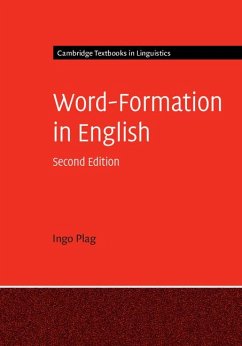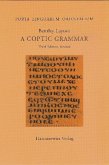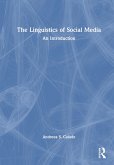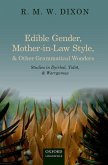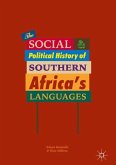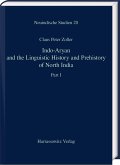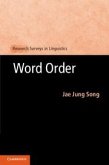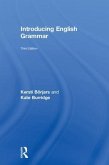Ingo Plag
Word-Formation in English
Ingo Plag
Word-Formation in English
- Gebundenes Buch
- Merkliste
- Auf die Merkliste
- Bewerten Bewerten
- Teilen
- Produkt teilen
- Produkterinnerung
- Produkterinnerung
The book enables students with little prior knowledge of linguistics to engage in their own analyses of complex words.
Andere Kunden interessierten sich auch für
![A Coptic Grammar A Coptic Grammar]() Bentley LaytonA Coptic Grammar68,00 €
Bentley LaytonA Coptic Grammar68,00 €![The Linguistics of Social Media The Linguistics of Social Media]() Andreea S. CaludeThe Linguistics of Social Media212,99 €
Andreea S. CaludeThe Linguistics of Social Media212,99 €![Edible Gender & Other Gramm Wonders C Edible Gender & Other Gramm Wonders C]() R. M. W DixonEdible Gender & Other Gramm Wonders C172,99 €
R. M. W DixonEdible Gender & Other Gramm Wonders C172,99 €![The Social and Political History of Southern Africa's Languages The Social and Political History of Southern Africa's Languages]() The Social and Political History of Southern Africa's Languages82,99 €
The Social and Political History of Southern Africa's Languages82,99 €![Indo-Aryan and the Linguistic History and Prehistory of North India Indo-Aryan and the Linguistic History and Prehistory of North India]() Claus Peter ZollerIndo-Aryan and the Linguistic History and Prehistory of North India104,99 €
Claus Peter ZollerIndo-Aryan and the Linguistic History and Prehistory of North India104,99 €![Word Order Word Order]() Jae Jung SongWord Order78,99 €
Jae Jung SongWord Order78,99 €![Introducing English Grammar Introducing English Grammar]() Kersti BörjarsIntroducing English Grammar195,99 €
Kersti BörjarsIntroducing English Grammar195,99 €-
-
-
The book enables students with little prior knowledge of linguistics to engage in their own analyses of complex words.
Hinweis: Dieser Artikel kann nur an eine deutsche Lieferadresse ausgeliefert werden.
Hinweis: Dieser Artikel kann nur an eine deutsche Lieferadresse ausgeliefert werden.
Produktdetails
- Produktdetails
- Verlag: Cambridge University Press
- Seitenzahl: 262
- Erscheinungstermin: 5. November 2018
- Englisch
- Abmessung: 250mm x 175mm x 19mm
- Gewicht: 639g
- ISBN-13: 9781107172098
- ISBN-10: 1107172098
- Artikelnr.: 50987702
- Herstellerkennzeichnung
- Libri GmbH
- Europaallee 1
- 36244 Bad Hersfeld
- gpsr@libri.de
- Verlag: Cambridge University Press
- Seitenzahl: 262
- Erscheinungstermin: 5. November 2018
- Englisch
- Abmessung: 250mm x 175mm x 19mm
- Gewicht: 639g
- ISBN-13: 9781107172098
- ISBN-10: 1107172098
- Artikelnr.: 50987702
- Herstellerkennzeichnung
- Libri GmbH
- Europaallee 1
- 36244 Bad Hersfeld
- gpsr@libri.de
Ingo Plag is Professor of English Linguistics at Heinrich-Heine-Universität Düsseldorf. He has published extensively in various linguistics journals, is editor-in-chief of the journal Morphology and is a member of the editorial board of a number of international journals including English Language and Linguistics, the Journal of English Linguistics, the Journal of Pidgin and Creole Languages, The Mental Lexicon and Zeitschrift für Sprachwissenschaft. His most recent books are Introduction to English Linguistics (2015), The Oxford Reference Guide to English Morphology (2013), and Word Knowledge and Word Usage: A Cross-disciplinary Guide to the Mental Lexicon (forthcoming).
Preface to the first edition
Preface to the second edition
Abbreviations and notational conventions
Introduction: what this book is about and how it can be used
1. Basic concepts
1.1. What is a word?
1.2. Studying word-formation
1.3. Inflection and derivation
1.4. Summary
Further reading
Exercises
2. Studying complex words
2.1. Identifying morphemes
2.1.1. The morpheme as the minimal linguistic sign
2.1.2. Problems with the morpheme: the mapping of form and meaning
2.2. Allomorphy
2.3. Establishing word-formation rules
2.4. Multiple affixation and compounding
2.5. Summary
Further reading
Exercises
3. Productivity and the mental lexicon
3.1. Introduction: what is productivity?
3.2. Possible and actual words
3.3. Complex words in the lexicon
3.4. Measuring productivity
3.5. Constraining productivity
3.5.1. Pragmatic restrictions
3.5.2. Structural restrictions
3.5.3. Blocking
3.6. Summary
Further reading
Exercises
4. Affixation
4.1. What is an affix?
4.2. How to investigate affixes: more on methodology
4.3. General properties of English affixation
4.3.1. Phonological properties
4.3.2. Morphological properties
4.3.3. Semantic properties
4.3.4. Classifying affixes
4.4. Suffixes
4.4.1. Nominal suffixes
4.4.2. Verbal suffixes
4.4.3. Adjectival suffixes
4.4.4. Adverbial suffixes
4.5. Prefixes
4.6. Infixation
4.7. Summary
Further reading
Exercises
5. Derivation without affixation
5.1. Conversion
5.1.1. The directionality of conversion
5.1.2. Conversion or zero-affixation?
5.1.3. Conversion: syntactic or morphological?
5.2. Prosodic morphology
5.2.1. Truncations: truncated names, -y diminutives, and clippings
5.2.2. Blends
5.3. Abbreviations and acronyms
5.4. Summary
Further reading
Exercises
6. Compounding
6.1. Recognising compounds
6.1.1. What are compounds made of?
6.1.2. More on the structure of compounds: the notion of head
6.1.3. Canonical and non-canonical compounds
6.1.4. Summary
6.2. An inventory of compounding patterns
6.3. Nominal compounds
6.3.1. Headedness
6.3.2. Interpreting nominal compounds
6.3.3. Stress assignment
6.4. Adjectival compounds
6.5. Verbal compounds
6.6
Neoclassical compounds
6.7. Compounding: syntax or morphology?
6.8. Summary
Further reading
Exercises
7. Theoretical issues: modelling word-formation
7.1. Introduction: why theory?
7.2. Phonology-morphology interaction
7.3. Affix ordering
7.4. The nature of word-formation rules
7.4.1. Morpheme-based morphology
7.4.2. Word-based morphology
7.4.3. Analogy
7.4.4. Naive Discriminative Learning
7.4.5. Summary
Further reading
Exercises
Answer key to exercises
Chapter 1
Chapter 2
Chapter 3
Chapter 4
Chapter 5
Chapter 6
Chapter 7
References
Index.
Preface to the second edition
Abbreviations and notational conventions
Introduction: what this book is about and how it can be used
1. Basic concepts
1.1. What is a word?
1.2. Studying word-formation
1.3. Inflection and derivation
1.4. Summary
Further reading
Exercises
2. Studying complex words
2.1. Identifying morphemes
2.1.1. The morpheme as the minimal linguistic sign
2.1.2. Problems with the morpheme: the mapping of form and meaning
2.2. Allomorphy
2.3. Establishing word-formation rules
2.4. Multiple affixation and compounding
2.5. Summary
Further reading
Exercises
3. Productivity and the mental lexicon
3.1. Introduction: what is productivity?
3.2. Possible and actual words
3.3. Complex words in the lexicon
3.4. Measuring productivity
3.5. Constraining productivity
3.5.1. Pragmatic restrictions
3.5.2. Structural restrictions
3.5.3. Blocking
3.6. Summary
Further reading
Exercises
4. Affixation
4.1. What is an affix?
4.2. How to investigate affixes: more on methodology
4.3. General properties of English affixation
4.3.1. Phonological properties
4.3.2. Morphological properties
4.3.3. Semantic properties
4.3.4. Classifying affixes
4.4. Suffixes
4.4.1. Nominal suffixes
4.4.2. Verbal suffixes
4.4.3. Adjectival suffixes
4.4.4. Adverbial suffixes
4.5. Prefixes
4.6. Infixation
4.7. Summary
Further reading
Exercises
5. Derivation without affixation
5.1. Conversion
5.1.1. The directionality of conversion
5.1.2. Conversion or zero-affixation?
5.1.3. Conversion: syntactic or morphological?
5.2. Prosodic morphology
5.2.1. Truncations: truncated names, -y diminutives, and clippings
5.2.2. Blends
5.3. Abbreviations and acronyms
5.4. Summary
Further reading
Exercises
6. Compounding
6.1. Recognising compounds
6.1.1. What are compounds made of?
6.1.2. More on the structure of compounds: the notion of head
6.1.3. Canonical and non-canonical compounds
6.1.4. Summary
6.2. An inventory of compounding patterns
6.3. Nominal compounds
6.3.1. Headedness
6.3.2. Interpreting nominal compounds
6.3.3. Stress assignment
6.4. Adjectival compounds
6.5. Verbal compounds
6.6
Neoclassical compounds
6.7. Compounding: syntax or morphology?
6.8. Summary
Further reading
Exercises
7. Theoretical issues: modelling word-formation
7.1. Introduction: why theory?
7.2. Phonology-morphology interaction
7.3. Affix ordering
7.4. The nature of word-formation rules
7.4.1. Morpheme-based morphology
7.4.2. Word-based morphology
7.4.3. Analogy
7.4.4. Naive Discriminative Learning
7.4.5. Summary
Further reading
Exercises
Answer key to exercises
Chapter 1
Chapter 2
Chapter 3
Chapter 4
Chapter 5
Chapter 6
Chapter 7
References
Index.
Preface to the first edition; Preface to the second edition; Abbreviations and notational conventions; Introduction: what this book is about and how it can be used; 1. Basic concepts; 1.1. What is a word?; 1.2. Studying word-formation; 1.3. Inflection and derivation; 1.4. Summary; Further reading; Exercises; 2. Studying complex words; 2.1. Identifying morphemes; 2.1.1. The morpheme as the minimal linguistic sign; 2.1.2. Problems with the morpheme: the mapping of form and meaning; 2.2. Allomorphy; 2.3. Establishing word-formation rules; 2.4. Multiple affixation and compounding; 2.5. Summary; Further reading; Exercises; 3. Productivity and the mental lexicon; 3.1. Introduction: what is productivity?; 3.2. Possible and actual words; 3.3. Complex words in the lexicon; 3.4. Measuring productivity; 3.5. Constraining productivity; 3.5.1. Pragmatic restrictions; 3.5.2. Structural restrictions; 3.5.3. Blocking; 3.6. Summary; Further reading; Exercises; 4. Affixation; 4.1. What is an affix?; 4.2. How to investigate affixes: more on methodology; 4.3. General properties of English affixation; 4.3.1. Phonological properties; 4.3.2. Morphological properties; 4.3.3. Semantic properties; 4.3.4. Classifying affixes; 4.4. Suffixes; 4.4.1. Nominal suffixes; 4.4.2. Verbal suffixes; 4.4.3. Adjectival suffixes; 4.4.4. Adverbial suffixes; 4.5. Prefixes; 4.6. Infixation; 4.7. Summary; Further reading; Exercises; 5. Derivation without affixation; 5.1. Conversion; 5.1.1. The directionality of conversion; 5.1.2. Conversion or zero-affixation?; 5.1.3. Conversion: syntactic or morphological?; 5.2. Prosodic morphology; 5.2.1. Truncations: truncated names, -y diminutives, and clippings; 5.2.2. Blends; 5.3. Abbreviations and acronyms; 5.4. Summary; Further reading; Exercises; 6. Compounding; 6.1. Recognising compounds; 6.1.1. What are compounds made of?; 6.1.2. More on the structure of compounds: the notion of head; 6.1.3. Canonical and non-canonical compounds; 6.1.4. Summary; 6.2. An inventory of compounding patterns; 6.3. Nominal compounds; 6.3.1. Headedness; 6.3.2. Interpreting nominal compounds; 6.3.3. Stress assignment; 6.4. Adjectival compounds; 6.5. Verbal compounds; 6.6; Neoclassical compounds; 6.7. Compounding: syntax or morphology?; 6.8. Summary; Further reading; Exercises; 7. Theoretical issues: modelling word-formation; 7.1. Introduction: why theory?; 7.2. Phonology-morphology interaction; 7.3. Affix ordering; 7.4. The nature of word-formation rules; 7.4.1. Morpheme-based morphology; 7.4.2. Word-based morphology; 7.4.3. Analogy; 7.4.4. Naive Discriminative Learning; 7.4.5. Summary; Further reading; Exercises; Answer key to exercises; Chapter 1; Chapter 2; Chapter 3; Chapter 4; Chapter 5; Chapter 6; Chapter 7; References; Index.
Preface to the first edition
Preface to the second edition
Abbreviations and notational conventions
Introduction: what this book is about and how it can be used
1. Basic concepts
1.1. What is a word?
1.2. Studying word-formation
1.3. Inflection and derivation
1.4. Summary
Further reading
Exercises
2. Studying complex words
2.1. Identifying morphemes
2.1.1. The morpheme as the minimal linguistic sign
2.1.2. Problems with the morpheme: the mapping of form and meaning
2.2. Allomorphy
2.3. Establishing word-formation rules
2.4. Multiple affixation and compounding
2.5. Summary
Further reading
Exercises
3. Productivity and the mental lexicon
3.1. Introduction: what is productivity?
3.2. Possible and actual words
3.3. Complex words in the lexicon
3.4. Measuring productivity
3.5. Constraining productivity
3.5.1. Pragmatic restrictions
3.5.2. Structural restrictions
3.5.3. Blocking
3.6. Summary
Further reading
Exercises
4. Affixation
4.1. What is an affix?
4.2. How to investigate affixes: more on methodology
4.3. General properties of English affixation
4.3.1. Phonological properties
4.3.2. Morphological properties
4.3.3. Semantic properties
4.3.4. Classifying affixes
4.4. Suffixes
4.4.1. Nominal suffixes
4.4.2. Verbal suffixes
4.4.3. Adjectival suffixes
4.4.4. Adverbial suffixes
4.5. Prefixes
4.6. Infixation
4.7. Summary
Further reading
Exercises
5. Derivation without affixation
5.1. Conversion
5.1.1. The directionality of conversion
5.1.2. Conversion or zero-affixation?
5.1.3. Conversion: syntactic or morphological?
5.2. Prosodic morphology
5.2.1. Truncations: truncated names, -y diminutives, and clippings
5.2.2. Blends
5.3. Abbreviations and acronyms
5.4. Summary
Further reading
Exercises
6. Compounding
6.1. Recognising compounds
6.1.1. What are compounds made of?
6.1.2. More on the structure of compounds: the notion of head
6.1.3. Canonical and non-canonical compounds
6.1.4. Summary
6.2. An inventory of compounding patterns
6.3. Nominal compounds
6.3.1. Headedness
6.3.2. Interpreting nominal compounds
6.3.3. Stress assignment
6.4. Adjectival compounds
6.5. Verbal compounds
6.6
Neoclassical compounds
6.7. Compounding: syntax or morphology?
6.8. Summary
Further reading
Exercises
7. Theoretical issues: modelling word-formation
7.1. Introduction: why theory?
7.2. Phonology-morphology interaction
7.3. Affix ordering
7.4. The nature of word-formation rules
7.4.1. Morpheme-based morphology
7.4.2. Word-based morphology
7.4.3. Analogy
7.4.4. Naive Discriminative Learning
7.4.5. Summary
Further reading
Exercises
Answer key to exercises
Chapter 1
Chapter 2
Chapter 3
Chapter 4
Chapter 5
Chapter 6
Chapter 7
References
Index.
Preface to the second edition
Abbreviations and notational conventions
Introduction: what this book is about and how it can be used
1. Basic concepts
1.1. What is a word?
1.2. Studying word-formation
1.3. Inflection and derivation
1.4. Summary
Further reading
Exercises
2. Studying complex words
2.1. Identifying morphemes
2.1.1. The morpheme as the minimal linguistic sign
2.1.2. Problems with the morpheme: the mapping of form and meaning
2.2. Allomorphy
2.3. Establishing word-formation rules
2.4. Multiple affixation and compounding
2.5. Summary
Further reading
Exercises
3. Productivity and the mental lexicon
3.1. Introduction: what is productivity?
3.2. Possible and actual words
3.3. Complex words in the lexicon
3.4. Measuring productivity
3.5. Constraining productivity
3.5.1. Pragmatic restrictions
3.5.2. Structural restrictions
3.5.3. Blocking
3.6. Summary
Further reading
Exercises
4. Affixation
4.1. What is an affix?
4.2. How to investigate affixes: more on methodology
4.3. General properties of English affixation
4.3.1. Phonological properties
4.3.2. Morphological properties
4.3.3. Semantic properties
4.3.4. Classifying affixes
4.4. Suffixes
4.4.1. Nominal suffixes
4.4.2. Verbal suffixes
4.4.3. Adjectival suffixes
4.4.4. Adverbial suffixes
4.5. Prefixes
4.6. Infixation
4.7. Summary
Further reading
Exercises
5. Derivation without affixation
5.1. Conversion
5.1.1. The directionality of conversion
5.1.2. Conversion or zero-affixation?
5.1.3. Conversion: syntactic or morphological?
5.2. Prosodic morphology
5.2.1. Truncations: truncated names, -y diminutives, and clippings
5.2.2. Blends
5.3. Abbreviations and acronyms
5.4. Summary
Further reading
Exercises
6. Compounding
6.1. Recognising compounds
6.1.1. What are compounds made of?
6.1.2. More on the structure of compounds: the notion of head
6.1.3. Canonical and non-canonical compounds
6.1.4. Summary
6.2. An inventory of compounding patterns
6.3. Nominal compounds
6.3.1. Headedness
6.3.2. Interpreting nominal compounds
6.3.3. Stress assignment
6.4. Adjectival compounds
6.5. Verbal compounds
6.6
Neoclassical compounds
6.7. Compounding: syntax or morphology?
6.8. Summary
Further reading
Exercises
7. Theoretical issues: modelling word-formation
7.1. Introduction: why theory?
7.2. Phonology-morphology interaction
7.3. Affix ordering
7.4. The nature of word-formation rules
7.4.1. Morpheme-based morphology
7.4.2. Word-based morphology
7.4.3. Analogy
7.4.4. Naive Discriminative Learning
7.4.5. Summary
Further reading
Exercises
Answer key to exercises
Chapter 1
Chapter 2
Chapter 3
Chapter 4
Chapter 5
Chapter 6
Chapter 7
References
Index.
Preface to the first edition; Preface to the second edition; Abbreviations and notational conventions; Introduction: what this book is about and how it can be used; 1. Basic concepts; 1.1. What is a word?; 1.2. Studying word-formation; 1.3. Inflection and derivation; 1.4. Summary; Further reading; Exercises; 2. Studying complex words; 2.1. Identifying morphemes; 2.1.1. The morpheme as the minimal linguistic sign; 2.1.2. Problems with the morpheme: the mapping of form and meaning; 2.2. Allomorphy; 2.3. Establishing word-formation rules; 2.4. Multiple affixation and compounding; 2.5. Summary; Further reading; Exercises; 3. Productivity and the mental lexicon; 3.1. Introduction: what is productivity?; 3.2. Possible and actual words; 3.3. Complex words in the lexicon; 3.4. Measuring productivity; 3.5. Constraining productivity; 3.5.1. Pragmatic restrictions; 3.5.2. Structural restrictions; 3.5.3. Blocking; 3.6. Summary; Further reading; Exercises; 4. Affixation; 4.1. What is an affix?; 4.2. How to investigate affixes: more on methodology; 4.3. General properties of English affixation; 4.3.1. Phonological properties; 4.3.2. Morphological properties; 4.3.3. Semantic properties; 4.3.4. Classifying affixes; 4.4. Suffixes; 4.4.1. Nominal suffixes; 4.4.2. Verbal suffixes; 4.4.3. Adjectival suffixes; 4.4.4. Adverbial suffixes; 4.5. Prefixes; 4.6. Infixation; 4.7. Summary; Further reading; Exercises; 5. Derivation without affixation; 5.1. Conversion; 5.1.1. The directionality of conversion; 5.1.2. Conversion or zero-affixation?; 5.1.3. Conversion: syntactic or morphological?; 5.2. Prosodic morphology; 5.2.1. Truncations: truncated names, -y diminutives, and clippings; 5.2.2. Blends; 5.3. Abbreviations and acronyms; 5.4. Summary; Further reading; Exercises; 6. Compounding; 6.1. Recognising compounds; 6.1.1. What are compounds made of?; 6.1.2. More on the structure of compounds: the notion of head; 6.1.3. Canonical and non-canonical compounds; 6.1.4. Summary; 6.2. An inventory of compounding patterns; 6.3. Nominal compounds; 6.3.1. Headedness; 6.3.2. Interpreting nominal compounds; 6.3.3. Stress assignment; 6.4. Adjectival compounds; 6.5. Verbal compounds; 6.6; Neoclassical compounds; 6.7. Compounding: syntax or morphology?; 6.8. Summary; Further reading; Exercises; 7. Theoretical issues: modelling word-formation; 7.1. Introduction: why theory?; 7.2. Phonology-morphology interaction; 7.3. Affix ordering; 7.4. The nature of word-formation rules; 7.4.1. Morpheme-based morphology; 7.4.2. Word-based morphology; 7.4.3. Analogy; 7.4.4. Naive Discriminative Learning; 7.4.5. Summary; Further reading; Exercises; Answer key to exercises; Chapter 1; Chapter 2; Chapter 3; Chapter 4; Chapter 5; Chapter 6; Chapter 7; References; Index.

